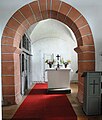St. Nicholas Church (Kornhochheim)
The St. Nikolaus Church is the Protestant church in Kornhochheim . It belongs to the Apfelstädt parish in the Gotha parish of the Evangelical Church in Central Germany .
History and equipment
The Romanesque building ( nave , choir square and apse ) is "easted" in the tradition of Christian church construction, ie built in an east-west direction, with the chancel in the east of the church. It dates from the second half of the 12th century and was initially laid out as a small Romanesque hall church without a tower. The choir square with the choir and triumphal arch as well as a bricked-up Romanesque window opening on the north side have been preserved. Around 1224 the choir square was increased to form the choir tower . This age could be seen on a beam in the tower. The bases , capitals and columns of the sound openings also bear the style of this time.
In the Middle Ages the church was a branch of Sülzenbrücken and belonged to Sedes Wandersleben and to the Archdiakonat St. Severi in Erfurt . It has been a Protestant preaching site since the Reformation . Politically, the village belonged to the Grafschaft Gleichen until 1444 , then until 1918 to the Ichtershausen district in the Free State of Saxony-Gotha . Kornhochheim was not inhabited for several years during the Thirty Years War .
The particularly beautiful Gothic entrance portal dates from the 15th century. It is made of sandstone and has beautiful ornaments and stonemason marks. Note the thick wooden door panel with well-preserved medieval wrought iron bands and decorative fittings and the rim lock that is still used for closing the door. Since the weight of the door leaf has led to subsidence, it will be repaired by wood and metal restorers from 2017. The door bears traces of weapons from the Thirty Years War (1618–1648).
At the end of the 17th century, the church was rebuilt and repaired several times (pulpit 1678, painting 1700/1701). The small organ at the top under the roof, partly built into the ceiling, is the work of organ builder Wanderslebener Johann Stephan Schmaltz from the year 1745 and has nine registers. It has mechanical wind chests and action and was after a thorough restoration on August 1st Re-inaugurated in 1992 with a festive concert. As far as we know today, it is the only essentially preserved organ by Schmaltz.
At the end of the 19th century the church was to be replaced by a new neo-Romanesque building. Of these plans, however, only an octagonal slate attachment was realized on the tower, which through its characteristic shape helped to determine the appearance of the place.
During the American artillery bombardment of the village in April 1945, the slate-covered tower spire and the roof structure were destroyed. In 1952 the tower was given a simple gable roof with a small, pointed roof turret.
At the beginning of the 21st century a child's grave from the 14th century was found in the course of the floor board renovation. The work turned out to be difficult because parts of the structure erected on it could collapse. For example the confessional in the apse, which was still used for private confessions in the Protestant church after the Reformation . The paintings above the confessional show the eleven pastors from Sülzenbrücken and Kornhochheim from the Reformation to the middle of the 18th century. A similar painting can be found in the church of Sülzenbrücken.
The church has a baroque sky from the beginning of the 18th century with peasant paintings in blue and gold in the form of a barrel ceiling . The rich paintings on the gallery balustrades show motifs from the Old and New Testament , which the Erfurt painter Thielemann created in 1701. In 1678 the pulpit with sound cover and narrow gate was donated and in October 1730 the color was repaired and designed. It shows motifs of the twelve year old Jesus and the evangelists.
Due to the artillery bombardment in April 1945, the original bell ringing from the 17th century was lost. It was replaced by three other bronze bells in 1963. Two of these come from the Stoermer company in Erfurt; they were cast in 1921–1922. The third bell, which is medium in size, was cast by Franz Schilling from Apolda in 1893. Extensive renovation work has been taking place on the inside and outside of the church since 1992. The church got a new paint job and a new belfry .
gallery
- more pictures of the church
Individual evidence
- Dirk Koch: Village churches around the three equals . Ingersleben 2006
- Arendt Schumann: A hike through built history - From Kornhochheim to Neudietendorf , Neudietendorf, anniversary edition 2000, ed. Neudietendorf community, Gotha art publisher
Web links
Coordinates: 50 ° 54 ′ 3.6 ″ N , 10 ° 54 ′ 55.7 ″ E











